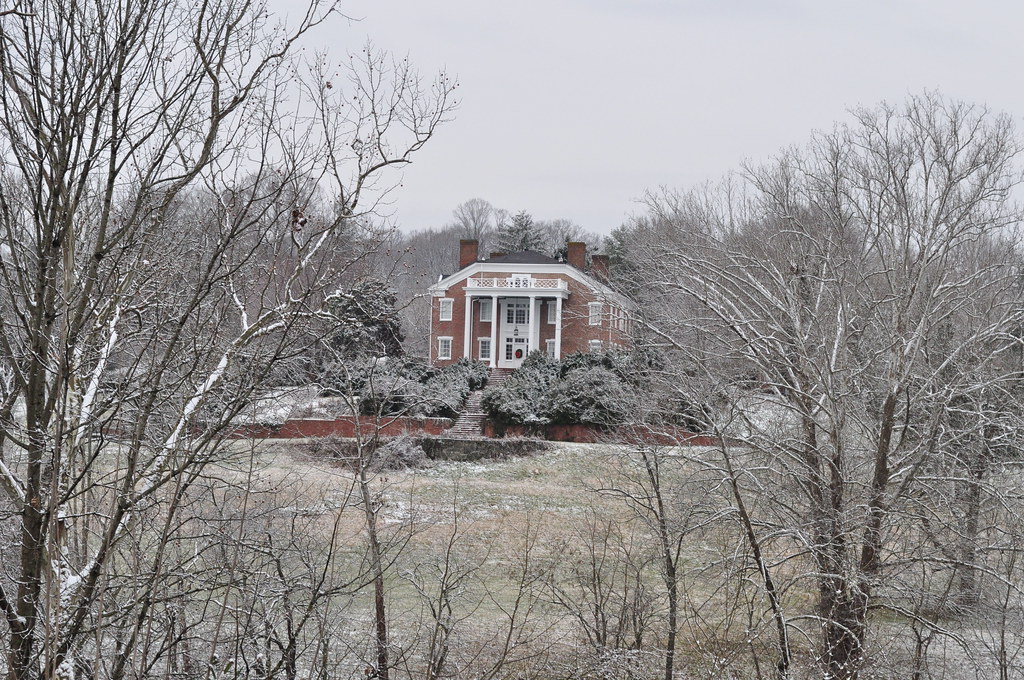Thanks to Library Assistant and Tennessee Room curator Zachary Harris for sharing the following regional ghost stories. If you enjoy this reading, you’ll be happy to know that Zachary will share more local history on our blog in the future. Keep an eye out for his recurring segment, “History Under the Blue Ridge.”
It is the season of the departed and a time for reflection on the past and future in this liminal space between fall and winter. Halloween, Samhain, or whichever winter’s eve celebration you prefer brings revitalized interest in the strange stories that surround us. As the library assistant who curates our regional history collections, I’ve found many paranormal stories while working with our Tennessee Room and Buffalo Mountain collections.
In the spirit of this spooky season, I’ve shared a few of these stories below. However, I’ve taken a different angle than the often lighthearted disconnection from history that Halloween stories tend to have. Instead, I want to share some “true” ghost stories with deep connections to Tri-Cities history.
Charles Edwin Price is a household name for any enthusiast of Tennessee storytelling. His stories run the gambit from humorous to deeply painful. They are painful because of the unfortunate historical roots underlying them. Price’s tales remind us that ghost stories that get passed down can help us wrestle with and understand historical traumas. Stories are not always complete fiction; in fact, oftentimes the opposite is true.
The following stories, which are found in Price’s Haints, Witches, and Boogers, are not for the faint of heart and touch on some painful local history. They are nonetheless important for us to grapple with.
These tales, along with many others, can be found in the Library’s Tennessee Room.
The Haunting of Long Island
Our first tale recounts the history of the Long Island in present-day Kingsport, Tennessee. Stories of the island involve “ghostly images of canoes and warriors,” “ghostly campfires,” and strange voices appearing on “the now-polluted waters of the Holston” and spring from a history of displacement, war, and grief.

The Long Island was a sacred place of peace for the Cherokee Nation where it was forbidden to harm any person. It served as a negotiating space for the Cherokee. After a period of prolonged warfare in 1776, the Cherokee and Euro-American settlers agreed to a peace on the Long Island that designated specific areas for settlers and Cherokee, lines which neither was supposed to cross.
However, as Price recounts it, this agreement did not last long. “There were just too many settlers moving into the area to allow the Indians exclusive territory,” so fighting broke out again. This rupture of the treaty and the subsequent removal of the Cherokee Nation resulted in the complete separation of the Cherokee from their ancestral mediating place. As legend goes, before they were driven away from the Long Island “a disgruntled medicine man cursed the ground.”
If you read the rest of Price’s account, the little island—now the site of a “waste-disposal plant”—abounds with stories of club-wielding killers, disappearances, and inexplicable madness. An important and painful piece of East Tennessee’s history lies at the base of these stories and is intertwined with the development of the places we now inhabit.
The Hell Hound of Rotherwood Mansion
Another story with roots in the tumultuous history of the Tri-Cities’ development is that of the infamous Rotherwood Mansion. Still located on the north fork of the Holston River, Rotherwood now appears relatively unassuming on the river’s banks.

The mansion’s mysterious tales go back to its earliest owners, who experienced a series of tragedies in the 1800s that ultimately led to their financial ruin. Around the start of the Civil War, the mansion’s owners sold it to a former slave overseer named Joshua Phipps who was known for his cruel tendencies. Phipps is remembered by descendants of Rotherwood’s enslaved population as having a “cruelty streak two miles wide.” Even his white neighbors in the generally pro-slavery area considered his treatment overly harsh and unnecessary.
The paranormal stories handed down by descendants of enslaved folks at Rotherwood revolve around Joshua Phipps’s death. As Price tells it, Phipps was allegedly “strangled by hundreds of flies,” much to the relief of the enslaved at Rotherwood.
Nowadays, it is said that on stormy nights a “Hound of Hell” tormented by a horde of flies can be seen wandering the grounds of Rotherwood Mansion. Along with this haunting tale of a terrible hound, other Rotherwood stories include a ghostly maniacal laugh said to belong to Phipps; an apparition that threatens violence against those staying at the mansion; and specters of enslaved people murdered while trying to escape through the local Underground Railroad.
These stories are macabre and grim to say the least. Still, they come from real people like Vic Phipps and Virgealia Ellis, who remembered them as told by their grandparents and great grandparents. Whether the tales of an unbreakable curse upon the Long Island or a tormented hellhound are real or not, these ghosts as conjured by local storytellers reveal the thoughts and attitudes of historical people who experienced considerable pain and grief.
Maybe connecting them back to real events takes away some of these tales’ mystery and magic. However, I think that mapping these connections brings us closer to our area’s history and joins the paranormal to real people and their intergenerational experiences.
Explore our Tennessee Room and Buffalo Mountain collection on the second floor for more regional history. Check out the current display in the Tennessee Room for other spooky stories as told by Charles Edwin Price.
More News





